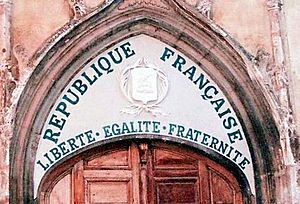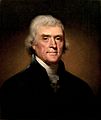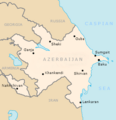Separation of church and state facts for kids
The idea of the separation of church and state means that the government and religious groups should be kept separate. This means the government should not control religion, and religious groups should not control the government. It's about making sure everyone has religious freedom and that the government treats all people fairly, no matter their beliefs.
This idea was mentioned by Thomas Jefferson, who was the third President of the United States. In 1802, he wrote a letter to a group called the Baptist Association in Danbury, Connecticut. He used the phrase "separation of church and state" to explain that the government should not interfere with people's religious practices.
In 1962, the Supreme Court of the United States used this idea in their decisions. They ruled that organized prayers in public schools were against the Constitution. Many countries around the world have also adopted this idea to keep government and religion separate.
Contents
What is Separation of Church and State?
The separation of church and state is a principle that says the government should not favor any one religion. It also means the government should not make laws based on religious beliefs. This helps protect people's right to believe (or not believe) what they want, without the government telling them what to do.
Why is this Idea Important?
This separation is important for several reasons:
- Protecting Freedom: It protects the freedom of people to practice any religion, or no religion at all. The government cannot force anyone to follow a certain faith.
- Fairness: It ensures that the government treats all citizens equally. It doesn't matter if someone is Christian, Muslim, Jewish, Hindu, or an atheist. Everyone gets the same rights and protections.
- Preventing Conflict: When government and religion are separate, it helps avoid conflicts that can happen when one tries to control the other.
History of the Idea
The idea of separating government and religion has a long history. Many thinkers and leaders have talked about it over centuries.
Early Thinkers and Ideas
Some early thinkers believed that people should be free to follow their own conscience. One important English philosopher named John Locke argued for individual conscience. He thought that the government should not control what people believe about religion. This was a big step towards the idea of religious freedom.
The United States and its Founders
In the United States, the idea of separation was very important to the country's founders. They wanted to make sure that the new government would not create a national religion, like some countries in Europe had.
- Thomas Jefferson: As mentioned, Thomas Jefferson used the phrase "separation of church and state." He also helped write the Virginia Statute for Religious Freedom. This law made sure that no one in Virginia could be forced to support a church or be punished for their religious beliefs.
- James Madison: Another important founder was James Madison. He helped write the Bill of Rights, which includes the First Amendment. The First Amendment says that Congress cannot make any law "respecting an establishment of religion." This means the government cannot set up an official religion or favor one religion over others.
Separation Around the World
Many countries today have some form of separation between church and state. The way they do it can be different, but the main goal is often the same: to ensure religious freedom and fair government.
France and Laïcité
France has a strong tradition of separation called "laïcité." This means that public life and government are strictly neutral on religious matters. For example, religious symbols are generally not allowed in public schools. This approach aims to create a public space where everyone, regardless of their beliefs, feels included.
Other Countries
Countries like Azerbaijan and Croatia also have laws that separate church and state in their constitutions. In Brazil, a leader named Rui Barbosa had a big influence on their 1891 Constitution, which also included the separation principle.
Images for kids
-
St. Augustine by Carlo Crivelli
-
Antichristus, a woodcut by Lucas Cranach the Elder of the pope using the temporal power to grant authority to a generously contributing ruler
-
John Locke, English political philosopher argued for individual conscience, free from state control.
-
Thomas Jefferson, the third President of the United States, whose letter to the Danbury Baptists Association is often quoted in debates regarding the separation of church and state
-
Rui Barbosa had a large influence upon the text adopted as the 1891 Constitution of Brazil.
-
Motto of the French republic on the tympanum of a church in Aups, Var département, which was installed after the 1905 law on the Separation of the State and the Church. Such inscriptions on a church are very rare; this one was restored during the 1989 bicentennial of the French Revolution.
-
James Madison, drafter of the Bill of Rights
-
Thomas Jefferson's tombstone. The inscription, as he stipulated, reads, "Here was buried Thomas Jefferson, author of ... the Statute of Virginia for Religious Freedom ...."
See also
 In Spanish: Separación Iglesia-Estado para niños
In Spanish: Separación Iglesia-Estado para niños












